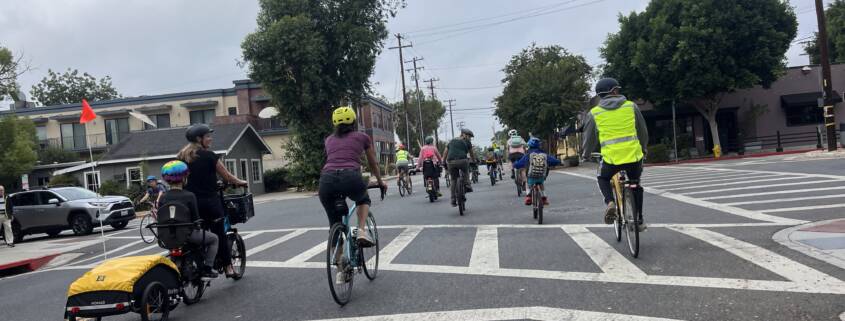Arroyo Vista’s Bike Bus: A Community in Motion
It was a verdant September morning in South Pasadena when we joined the Arroyo Vista Elementary School Bike Bus. The sun was just beginning to warm the streets, bicycle bells rang out like punctuation marks, and the K-pop Demon Hunters soundtrack floated through the air. What could have been a routine Tuesday became something else entirely: a glimpse of how change takes root, not in sweeping gestures, but in the day-to-day choices of families who decide to ride together, transforming children’s bicycles from a toy into a tool to get around their neighborhood.
The Arroyo Vista & Marengo Elementary bike buses began under the guidance of South Pas Active, a local advocacy group, and has since been adopted and nurtured by parents and the PTA. What started as a one time event two years ago is now a fixture of school life — a weekly ritual that some students have carried with them into their middle school years, graduating from a group ride to daily independent commutes.
How They Got Rolling
Like any good bike ride, momentum built steadily, thanks to the persistence of parents like Andrea Knopf and Kristen Pumphrey. Both recognized early on that the bike bus couldn’t survive on enthusiasm alone — it needed institutional backing and community buy-in. Kristen worked from the inside to secure formal support within the PTA, ensuring the program had legitimacy and visibility within the school. Andrew, living just blocks away from Arroyo Vista, brought the day-to-day commitment: showing up, organizing families, and treating the bike bus as an extension of her own front yard.
Together, they transformed a neighborhood experiment into a schoolwide tradition. Their efforts rippled outward: families rallied to protect the bike lanes that made the routes possible, gathering 200 signatures to preserve Grand Avenue Slow Streets. And with PTA support, the initiative expanded further, leading to the creation of a complementary “walk bus” that now runs every Friday.
Overcoming Concerns
Parents’ first questions were predictable: Is it safe? Will it take too much time? The answers, Andrea and Kristen found, came through practice. “Safety in numbers” is more than a slogan, it’s lived in reality. And once families saw the joy of riding together, the excuses lost their hold.
Keys to Success
- Consistency: rain or shine, the bike bus rolls.
- Commitment: three or four parents who won’t quit form the backbone.
- Community: WhatsApp chats keep coordination casual; school newsletters and PTA updates make it official.
- Partnership: the school added bike racks, extended cones to hold space, and the principal now references the bike bus with pride.
Andrea captured the spirit of it best: “I had tears in my eyes because we are building something amazing.”
Getting Started? Start Simple.
- Begin with one route, one day a week.
- Younger kids (especially K–2) usually ride with a caregiver.
- Independence grows over time; several riders now commute daily to middle school.
- Follow the “always bring a friend” rule to build momentum.
Looking Ahead
The bike bus has become woven into the culture of Arroyo Vista. This October, the PTA and parents will host an on-campus bike clinic with tune-ups, safety fittings, and a bike rodeo. What began as an experiment is now a tradition — and a testament to what happens when advocacy connects with community.
At Arroyo Vista, biking to school is no longer just a way to get from home to class. It is a story about independence, about building trust, about the joy of starting the day in motion. And most of all, it is a reminder that the future of safe streets begins here, with kids who believe riding together is simply the way to go.





